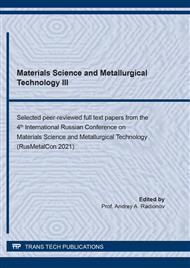[1]
S.V. Kostyuchenko, S.V. Volkov, A.V. Yakimenko, V.T. Mazaev, S.Yu. Shishov, Disinfection in the preparation of drinking water from surface sources, Water Supply and Sanitary Ware. 2 (2000) 9-12.
Google Scholar
[2]
Yu.A. Rakhman, E.V. Shtannikov, I.E. Ilyin et al., Study of the danger of halogenated organic compounds formed during the chlorination of drinking water, Hygiene and Sanitation. 3 (1985) 4-7.
Google Scholar
[3]
L.P. Alekseeva, V.L. Draginsky, Formation of by-products during water disinfection and methods for reducing their concentration, in: Technologies for Water Purification TECHNOVOD-2004,: Materials of the Intern. Scientific-Practical. Conf. Dedicated to the 100th Anniversary of SRSTU (NPI), LLC NPO Temp, Novocherkassk, 2004, pp.83-86.
Google Scholar
[4]
V.L. Draginsky, L.P. Alekseeva, Ways to solve the problem of reducing the concentration of organochlorine compounds formed during chlorination of water, in: Technologies for Water Purification TECHNOVOD-2008,: Materials of the IV Intern. Scientific-Pract. Conf., Onyx+, Novocherkassk, 2008, pp.18-24.
Google Scholar
[5]
L.I. Gunther, L.P. Alekseeva, Ya.L. Khromchenko, Influence of organic impurities in natural water on the formation of toxic volatile halogenated alkanes during its chlorination, Chemistry and Technology of Water. 8(1) (1986) 37-41.
Google Scholar
[6]
L.I. Gunther, L.P. Alekseeva, Ya.L. Khromchenko, Influence of inorganic impurities of natural waters on the formation of chloroform in drinking water, Chemistry and Technology of Water. 10(2) (1988) 110-112.
Google Scholar
[7]
L.P. Alekseeva, Ya.L. Khromchenko, Influence of conditions of reagent water treatment on the formation of chloroform, Chemistry and Technology of Water. 10(2) (1988) 140-144.
Google Scholar
[8]
V.A. Prokopov, E.D. Maktaz, G.V. Tolstopyatova, Influence of individual factors on the formation of trihalomethanes in chlorinated water, Chemistry and Technology of Water. 15(9-10) (1993) 633-640.
Google Scholar
[9]
B.V. Vasiliev, Yu.A. Trukhin, E.A. Evelson, Disinfection of wastewater at treatment facilities of the State Unitary Enterprise Vodokanal of St. Petersburg,, Water Supply and Sanitary Ware. 10 (2000) 22-25.
Google Scholar
[10]
A.Yu. Skryabin, L.N. Fesenko, S.I. Ignatenko, I.V. Pchelnikov, Formation of volatile organochlorine compounds during the disinfection of the Don water with chlorine-containing reagents, Water Supply and Sanitary Ware. 7 (2020) 4-10.
Google Scholar
[11]
V.A. Usoltsev, T.A. Krasnova, N.I. Baranova, Investigation of the coagulation process in the primary chlorination of water, Water Supply and Sanitary Ware. 11 (1994) 9-11.
Google Scholar
[12]
L.N. Fesenko, A.Yu. Skryabin, S.A. Breus, I.V. Pchelnikov, Production tests of drinking water disinfection by direct electrolysis, Water Supply and Sanitary Ware. 5 (2017) 15-20.
Google Scholar
[13]
L.N. Fesenko, S.I. Ignatenko, I.V. Pchelnikov, Improvement of sodium hypochlorite production technology by electrolysis of seawater, Water Supply and Sanitary Ware. 1 (2015) 11-20.
Google Scholar
[14]
I.V. Pchelnikov, L.N. Fesenko, A.S. Terikov, S.I. Ignatenko, Obtaining sodium hypochlorite by direct electrolysis of low-mineralized water, in: Technologies for Water Purification TECHNOVOD-2017, Materials of the X - Jubilee International Scientific and Practical Conference, 2017, pp.73-78.
Google Scholar
[15]
L.N. Fesenko, R.V. Fedotov, Comparative assessment of resistance of hardwearing anodes, ternary coated with iridium, ruthenium, and titanium, Solid State Phenomena. 265 (2017) 580-586.
DOI: 10.4028/www.scientific.net/ssp.265.580
Google Scholar
[16]
I. Pchelnikov, R.V. Fedotov, S.A. Breus, On the choice of the water treatment technology for rural areas, IOP Conf. Ser.: Mater. Sci. Eng. 962 (2020) 1-9.
DOI: 10.1088/1757-899x/962/4/042083
Google Scholar
[17]
V.N. Shvetsov, K.M. Morozova, L.N. Fesenko, A.Yu. Scryabin, A.I. Vergunov, Chlorine and organobromine compounds in drinking water: methods of their removal, Water Supply and Sanitary Ware. 2 (2014) 30-35.
Google Scholar
[18]
A.I. Vergunov, Don water purification in a biosorption-membrane reactor, in: Yakovlevskie Readings: Collection of Reports of XI Scientific and Technical Conf., in Memory of Acad. of RAS Sergei Vasilievich Yakovlev, ASV, Moscow, 2016, pp.36-38.
Google Scholar
[19]
A.I. Vergunov, Biosorption-membrane technology for purifying the Don water, Bulletin of SGASU Urban Planning and Architecture. 2 (23) (2016) 23-26.
Google Scholar
[20]
Fesenko L. N., Vergunov A. I., Shvetsov V. N., Morozova K. M., Kostyukov V.P. Biosorption membrane reactor with flat filtering elements: calculation method // Water supply and sanitary ware. - 2017. - No. 4. - P. 12-17.
Google Scholar
[21]
GOST 18190-72. Potable Water. Methods for Determining the Content of Active Chlorine, Publishing House of Standards, Moscow, (1976).
Google Scholar
[22]
M. Henze, Wastewater Treatment. Biological and Chemical Processes, Mir, Moscow, (2004).
Google Scholar
[23]
M. Dixon, E. Webb, Enzymes: Translated from English, Vol. 1, third ed., Mir, Moscow, (1982).
Google Scholar


